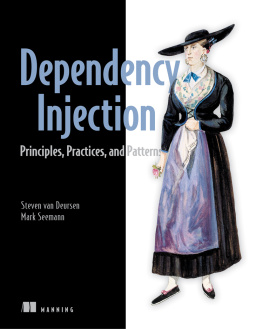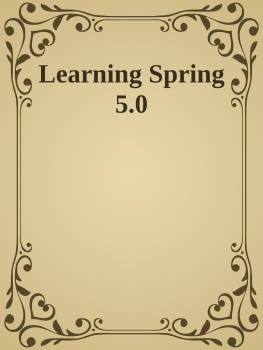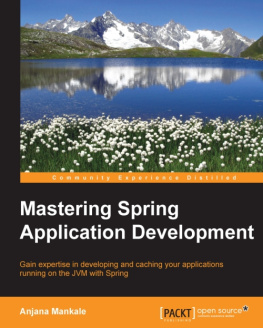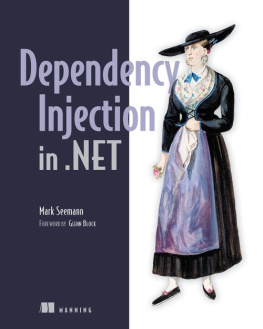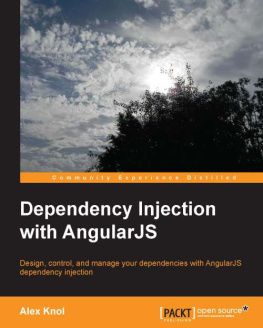Nilang Patel - Java 9 Dependency Injection: Write loosely coupled code with Spring 5 and Guice
Here you can read online Nilang Patel - Java 9 Dependency Injection: Write loosely coupled code with Spring 5 and Guice full text of the book (entire story) in english for free. Download pdf and epub, get meaning, cover and reviews about this ebook. year: 2018, publisher: Packt Publishing, genre: Computer. Description of the work, (preface) as well as reviews are available. Best literature library LitArk.com created for fans of good reading and offers a wide selection of genres:
Romance novel
Science fiction
Adventure
Detective
Science
History
Home and family
Prose
Art
Politics
Computer
Non-fiction
Religion
Business
Children
Humor
Choose a favorite category and find really read worthwhile books. Enjoy immersion in the world of imagination, feel the emotions of the characters or learn something new for yourself, make an fascinating discovery.

- Book:Java 9 Dependency Injection: Write loosely coupled code with Spring 5 and Guice
- Author:
- Publisher:Packt Publishing
- Genre:
- Year:2018
- Rating:4 / 5
- Favourites:Add to favourites
- Your mark:
Java 9 Dependency Injection: Write loosely coupled code with Spring 5 and Guice: summary, description and annotation
We offer to read an annotation, description, summary or preface (depends on what the author of the book "Java 9 Dependency Injection: Write loosely coupled code with Spring 5 and Guice" wrote himself). If you haven't found the necessary information about the book — write in the comments, we will try to find it.
Create clean code with Dependency Injection principles
Key Features- Use DI to make your code loosely coupled to manage and test your applications easily on Spring 5 and Google Guice
- Learn the best practices and methodologies to implement DI
- Write more maintainable Java code by decoupling your objects from their implementations
Dependency Injection (DI) is a design pattern that allows us to remove the hard-coded dependencies and make our application loosely coupled, extendable, and maintainable. We can implement DI to move the dependency resolution from compile-time to runtime. This book will be your one stop guide to write loosely coupled code using the latest features of Java 9 with frameworks such as Spring 5 and Google Guice.
We begin by explaining what DI is and teaching you about IoC containers. Then youll learn about object compositions and their role in DI. Youll find out how to build a modular application and learn how to use DI to focus your efforts on the business logic unique to your application and let the framework handle the infrastructure work to put it all together.
Moving on, youll gain knowledge of Java 9s new features and modular framework and how DI works in Java 9. Next, well explore Spring and Guice, the popular frameworks for DI. Youll see how to define injection keys and configure them at the framework-specific level. After that, youll find out about the different types of scopes available in both popular frameworks. Youll see how to manage dependency of cross-cutting concerns while writing applications through aspect-oriented programming.
Towards the end, youll learn to integrate any third-party library in your DI-enabled application and explore common pitfalls and recommendations to build a solid application with the help of best practices, patterns, and anti-patterns in DI.
What you will learn- Understand the benefits of DI and fo from a tightly coupled design to a cleaner design organized around dependencies
- See Java 9s new features and modular framework
- Set up Guice and Spring in an application so that it can be used for DI
- Write integration tests for DI applications
- Use scopes to handle complex application scenarios
- Integrate any third-party library in your DI-enabled application
- Implement Aspect-Oriented Programming to handle common cross-cutting concerns such as logging, authentication, and transactions
- Understand IoC patterns and anti-patterns in DI
This book is for Java developers who would like to implement DI in their application. Prior knowledge of the Spring and Guice frameworks and Java programming is assumed.
Table of Contents- Why Dependency Injection?
- Dependency Injection in Java 9
- Dependency Injection with Spring
- Dependency Injection with Google Guice
- Scopes
- Aspect-Oriented Programming and Interceptors
- IoC Patterns and Best Practices
Nilang Patel: author's other books
Who wrote Java 9 Dependency Injection: Write loosely coupled code with Spring 5 and Guice? Find out the surname, the name of the author of the book and a list of all author's works by series.

